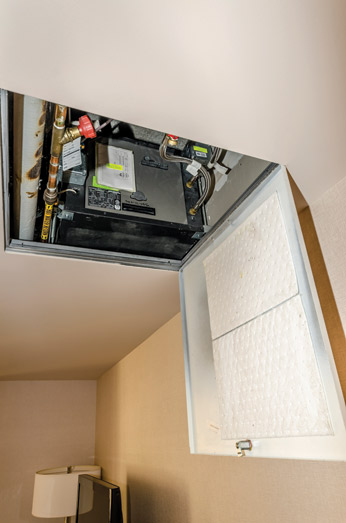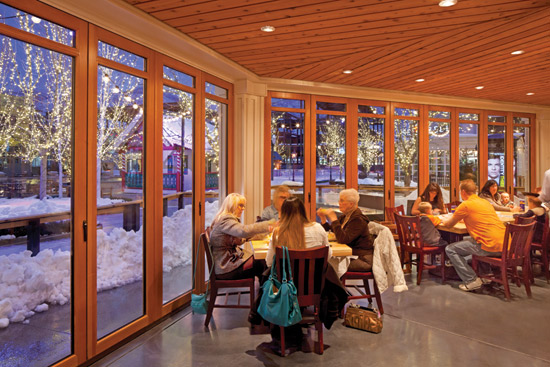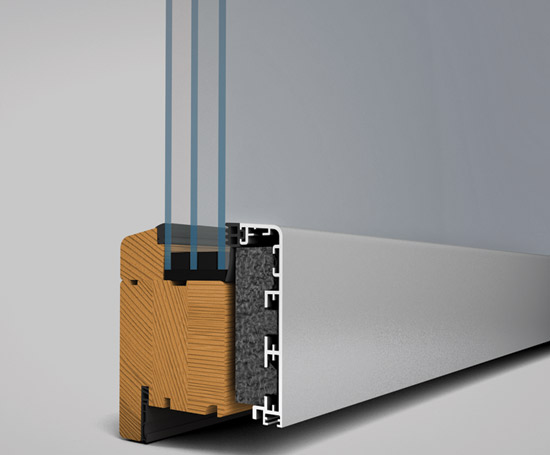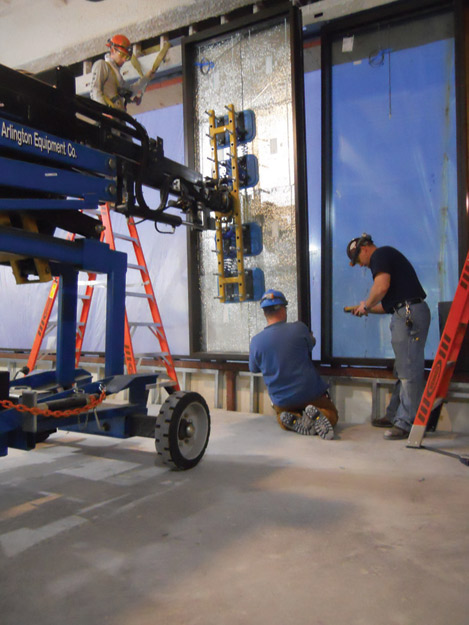High-Performance Green Trends
New materials save energy, the environment, and promote collaboration in high-performance green buildings
![]() Continuing Education
Continuing Education
Use the following learning objectives to focus your study while reading this month’s Continuing Education article.
Learning Objectives - After reading this article, you will be able to:
- Discuss high-performance thin insulation modules that contribute to meeting stringent green building rating systems for zero energy targets.
- Describe innovative, energy-efficient, and space-saving water-source heat pumps that optimize controllability of systems by using thermostats controlled at central command centers or through mobile devices.
- Identify new FSC-certified wood exterior decking produced from common domestic species and street furniture composed of lumber upcycled from urban forests.
- Define sustainable components from thermal performance to human well-being of high-performance, flexible opening wall systems.
The green movement has led to growing changes in the materials and products that architects now specify for all buildings—not just those meeting green ratings. The American Institute of Architects has developed a brief history of green materials and is providing guidelines for choosing green products and materials. On their website, they are surveying architects to learn more about their choices. According to the AIA, “As architects, we specify materials every day. Our decisions affect the environment, our communities, and our health. Harnessing the evolving body of knowledge about the impact of materials is integral to improving the craft, science, and art of architecture.”1 This AIA initiative supports the growing trend to specify high-performance materials, systems, and products to increase energy efficiency, conserve water, provide more usable floor space, and reuse renewable resources for a sustainable future.
It has been almost 25 years since the American Institute of Architects published the Environmental Resource Guide or ERG, the USGBC posted LEED 1.0 for public review, and the National Institute of Standards and Technology published a new methodology for life-cycle analysis of building materials—Building for Environmental and Economic Sustainability (BEES). Since then, the commitment to developing green buildings and green building products has been exponential in growth.
Today, product manufacturers and engineers are pushing the boundaries of sustainability, with many focused on energy efficiency and water conservation. As Tony Landers, commercial marketing manager at ClimateMaster, comments, “If you look at America as a whole, the electric grid is antiquated, the energy grid is at its maximum, and there is a need to design products to reduce the demand for energy. Studies show that 40 percent of carbon emissions can be attributed to buildings' use of energy. When we analyze the impact of building systems on the longevity of the electric grid, attacking this 40 percent of the energy pie is the easiest adaptation we can make to our products.” He continues, “In addition, conserving water by providing a more efficient water source is also important to the sustainability and health of the planet.”

Photo courtesy of NanaWall Systems, CenterCal Properties
An outdoor stage and additional seating areas were created by the installation of an opening glass wall at Settebello Restaurant, Station Park, Farmington, Utah.
Manufacturers are achieving new gains while using common materials and methods from curtain walls to wood deck construction. Dow Corning's New Business Market Development Leader Paul Wisniewski comments, “By making the latest innovation and technology work within current construction techniques, manufacturers can help engineers, architects, and contractors deliver needed game-changing improvements in energy efficiency without requiring applicator retraining or specialized equipment. From eliminating traditionally overlooked thermal losses from thermal bridging and poorly constructed air barriers to delivering substantial improvements in curtain wall thermal performance, high-performance building solutions are necessary to help meet tomorrow's green building challenges today.”

Photo courtesy of Tournesol Siteworks
Patagonia, Inc. of Ventura, California, specified these benches to be constructed from thermally modified ash that has properties similar to that of South American hardwoods.
Chris Lyon at Tournesol Siteworks, a manufacturer of commercial landscape solutions, describes sustainability as a trend towards creating alternatives to vanishing materials such as wood from old-growth forests. He believes that this trend comes from a realization within the specifier communities. “While the owners are driving the use of products based on the performance, specifiers realize that using old-growth wood isn't sustainable. Thirty years ago, architects specified old-growth redwood, today it's South American Ipe. Product manufacturers have been focusing on developing domestic alternatives, and thinking about ways wood can be upcycled. An exciting new opportunity is the use of urban wood such as from the many trees that are being cut down due to the emerald ash borer.”
The latest innovations are adding to the portfolios of designers specifying products that take advantage of new research and advanced engineering. Some of these imaginative and innovative new products include the following:
Smart HVAC systems. Architects can now specify smart systems that allow clients to adjust the temperature of their homes or condominiums from a cell phone.
Opening walls in offices and classrooms are removing boundaries and encouraging collaboration. Architects are also designing restaurants with opening walls which provide a seamless transition between the inside and outside. These opening walls have higher thermal performance values that can contribute rather than detract from green building rating systems.
Water-source heat pumps. Historic properties are being renovated with small, water-conserving, water-source heat pumps located in ceiling cavities.
New exterior decking is available using thermally modified lumber from domestic and urban forests.
The use of thin insulation panels and blankets has made creating net-zero or highly efficient thermal envelopes easier.
Targeting Zero Energy
Many architects are committed to the reduction of energy consumption over the next few years, guided by numerous green rating systems. They know that they need to combine different strategies to achieve energy efficiency and sometimes meet net-zero goals for their buildings.
Addressing the building envelope requires an analysis of numerous factors. Focusing on the greater losses requires the architect to carefully specify materials that are highly efficient. David Posada, LEED AP, BD + C, CPHC, sustainability manager at GBD Architects, commented on his use of a new building insulation blanket in combination with sunshades at the Kiln Apartments in Portland, Oregon. “As energy codes have gotten more stringent, much of the 'low-hanging fruit' of energy efficiency has already been picked. Code now requires better insulation and higher-performing windows, and the market is making more efficient lighting and HVAC equipment more affordable.”
The new dining hall at the University of Alaska Fairbanks is located in a climate where the temperatures can drop to -45 degrees F in the winter, which created a construction challenge for architect Perkins+Will. The architect was committed to the creation of a highly efficient thermal envelope that also allowed views to the night sky. According to Carsten Stinn, project manager and designer for Perkins+Will, “The building is intended to have an open and airy feeling and the amount of daylight and views to the outside was an important design factor. One of the main inspirations for this design was the beautiful, vast Alaskan sky; we wanted large windows to showcase the aurora borealis.”
To address these challenges, the project team looked to a new solution—architectural insulation modules, which feature vacuum insulation panel (VIP) technology.
Vacuum insulation panels contain a pressed fumed-silica core contained within a multilayer, aluminized bag under vacuum that delivers initial performance of RSI 5.6 to RSI 6.2 per 25 mm (R-32 to R-35 per inch) at center of panel—substantially better than typical mineral wool insulation, which would need to be 8 to 10 times thicker to deliver an equivalent R-value. Available in pre-engineered sizes, VIP is often used in architectural insulation module form for panel protection and ease of installation.
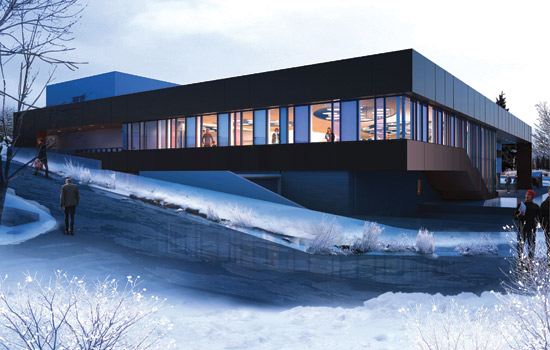
Photo courtesy of Perkins+Will
The University of Alaska Fairbanks, in Fairbanks, Alaska, is monitoring the performance of new architectural vacuum insulation panels, shown between the working glass windows that incorporate new high-performance insulation.
Architectural insulation modules integrate VIP within a protective architectural finish. These modules combine the aesthetics and convenience of curtain wall construction with the added energy-saving benefit of high-performance insulation. These units can be installed using standard construction methods and techniques typical of those currently used for insulated glass in curtain wall structures—no special handling is required. Architectural insulation modules enable new design possibilities for zero-energy buildings, significantly increased thermal resistance in space-limited situations, and the creation of slim wall constructions with high R-value performance.
Using a 1-7/8-in.-thick architectural insulation module with an R-value of 49, the architect was able to minimize heat loss and use traditional spandrel glass configurations to keep a slim building profile. Committed to energy efficiency on the campus, the university is monitoring the energy use of this new building as part of research and teaching goals for their engineering program. “We work hard to display the best techniques for the arctic in a way that also delivers real-life educational experiences to our students,” says Jenny Campbell, senior project manager in facility services, design, and construction for the university. “Here at the university, we are continually searching for ways to increase energy efficiency. We have our own heating and cooling plant on campus, so the more efficient our buildings are, the less it costs us.”
Saving Energy and Saving Space with Smart HVAC Systems
Small, efficient water-source heat pumps are being used in both renovations and new construction to save space while providing energy-efficient HVAC equipment. These units can be operated with traditional thermostats or smart controls from a central HVAC command station. Some products can be controlled from an application on a mobile device.
Vertical stack units operate quietly and can be placed in walls. Unobtrusive cabinets or small closets are constructed to contain units that provide individual client controls. Unit sizes can be as small as 24 inches by 24 inches and be sheet rocked into a wall. Other models can be mounted in a ceiling or in a small closet. Unlike earlier configurations for water-source heat pumps, they do not need direct access to an outdoor wall. Units can be controlled through a smart thermostat from a mobile device. Clients can warm or cool their units as needed. When used in hotel applications, these systems provide an “eco mode” that can sense if a room is occupied or when someone has left or entered the room to turn the unit on or off. They operate virtually undetected by a hotel guest.
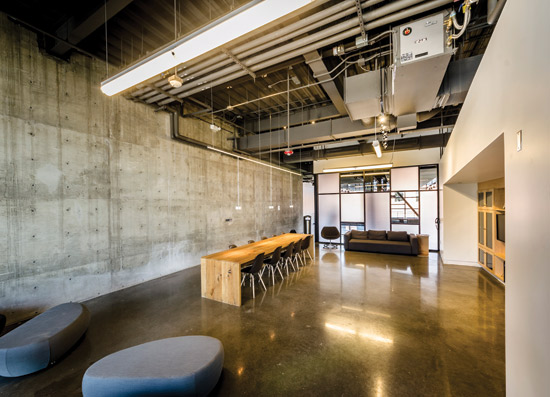
Photo by Skywall Photography, courtesy of ClimateMaster
Guthrie Green is a renovated paper plant with a large geothermal borehole field, which ties into a hybrid system of geothermal heat pumps and a ground-mounted cooling tower. The combination of the geothermal field with the water-source heat pumps provides the capability of reducing heating and cooling costs by approximately 60 percent.
For example, when considering a heating system for a new Kimpton Hotel, the hotel's engineering team and the architects were searching for a solution for an efficient, space-saving mechanical system that would maintain the modern appearance of the design which included floor-to-ceiling windows in all of the guest rooms. They also needed to meet the Chicago Energy Conservation Code (CECC) while maximizing occupant comfort.
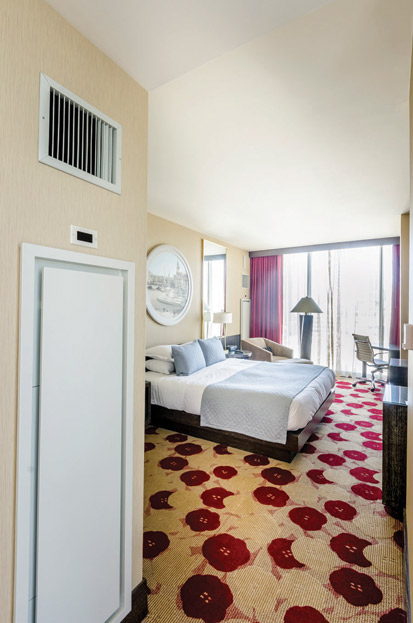
Photo by Skywall Photography, courtesy of ClimateMaster
Designed by GREC Architects, Hotel Palomar in Chicago, Illinois, provides an elevated level of guest comfort and achieves energy efficiency goals with a highly efficient water-source heat pump system integrated into the hotel room interior as a wall panel.
“A heat pump-driven system was the only design that met all stipulations of the project,” explains Gary Stern, vice president at Imbert International, a consultant on the project. “This included the energy goals and budget parameters, as well as the ability to separate the residential portion of the building from the hotel.” The mechanical system design facilitates the independent operation of the private residences and hotel units when in heating mode. And when in cooling mode, both areas share only a cooling tower on the roof.” Specifying a water-source heat pump requires the understanding of the Energy Efficiency Ratio or EER.
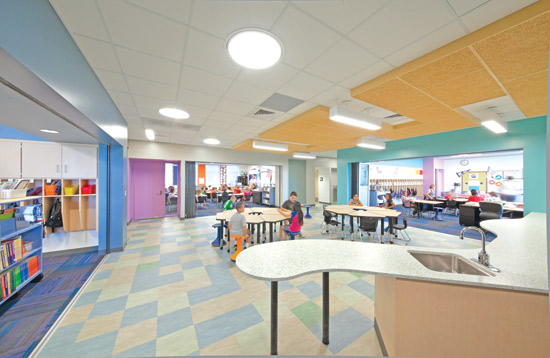
Photo courtesy of NanaWall Systems
New flexible walls remove boundaries, allowing architects to encourage collaborative learning for schools of the 21st century.
The American Heating and Refrigeration Institute rates the efficiency of HVAC equipment through a third-party certification system based on random audits. An EER is a measure of the Btu's per hour for each watt of power an air conditioner uses. According to the Department of Energy, higher EER ratings identify more efficient air conditioners. National appliance standards require room air conditioners to have an EER ranging from 8.0–9.8 or greater, depending on the type and capacity. ENERGY STAR®-qualified room air conditioners have even higher EER ratings. New water-source heat pumps can have EERs between 13-14 and when connected to a geothermal loop the EER can be as high as 45 for some high-performance units.
When the mechanical system for Tulsa's renovated paper company building was designed, inserting small HVAC units in the ceiling was a space-saving decision. Flynt & Kallenberger project manager Justin Roush shared that the “greenest” component of Guthrie Green's sustainable building plan actually lays below the grass, benches, and stage. This is where a field of 120 500-foot geothermal boreholes was drilled prior to the above-ground construction, which ties into a hybrid system of geothermal heat pumps and a ground-mounted cooling tower. This serves as the main mechanical system for the Tulsa Paper Company and Hardesty Arts Center buildings. The geothermal borehole field, organized into 15 operating circuits, provides 600 tons of heating and cooling to both buildings, with the capability of reducing heating and cooling costs by approximately 60 percent.
“The 600 tons from the geothermal field is supplemented with a 200-ton closed circuit fluid cooler, which was incorporated into the overall system design when taking the peak demands of all four end-users into account,” says Roush. “Each of the tenants has a water-to-water heat exchanger that enables them to use the loop water on one side while keeping their individual systems separated. That way, if they wanted to create chilled water or put equipment on the roof and use glycol, these elements can't ultimately end up in the main loop water.”
Units with vertical stacking can share cooling towers, plumbing runs, and electrical conduits. This means that construction sequencing, materials, and installation can be streamlined. The maintenance of these plug-and-play units is provided by removing the one unit and replacing it with another, allowing for virtually no “down time” to operations of the heating and cooling units.
Using this system that saved electricity and conserved water in the renovation of this existing building helped the architects meet their sustainable design goals.
Opening Up Boundaries
The Global Development Research Center (GDRC), a non-profit think tank that carries out initiatives in education, research, and practice, lists 44 benefits to collaborative learning. According to the GDRC, the first 10 reasons that collaborative learning2 provides educational benefits are:
1. Develops higher level thinking skills
2. Promotes student-faculty interaction and familiarity
3. Increases student retention
4. Builds self esteem in students
5. Enhances student satisfaction with the learning experience
6. Promotes a positive attitude toward the subject matter
7. Develops oral communication skills
8. Develops social interaction skills
9. Promotes positive race relations
10. Creates an environment of active, involved, exploratory learning
Flexible spaces that promote collaborative learning provide better learning environments and continue to be an important part of the design laundry list requested by teachers, administrators, and parents.
According to Matt Thomas, marketing manager at NanaWall Systems, “the current trend in interiors for the schools of the 21st century is to provide shared space, brighter interiors with natural daylight and fresh air. When you have flexibility in room configurations and access to daylight and fresh air, the architect can design cost-saving, smaller buildings with reduced lighting and ventilation fan equipment. The increase in exposure to natural environments has been shown to increase learning and behavior in schools. A sustainable building removes barriers to learning.”
Using opening glass walls enables the separation of smaller groups for discussion, group projects, quiet zones, advanced or remedial work, test centers, teacher-assistant led groups. It allows teachers to monitor multiple activities in separated spaces and promotes teamwork. Parents or visitor volunteers in the classroom, can use these areas to work independently with students. Flexible workspaces can provide rooms that have common storage space for shared books, supplies, computers, and reduces redundant purchases. Joining two or more classrooms with shared space allows teachers to configure space to meet their needs and allows for a quick and easy transformation for shared classroom management or cool off/recovery areas for behavioral and emotional issues or disciplinary actions.
Opening glass walls can also facilitate daylight harvesting. Sharing daylight between spaces reduces the need for electrical lighting and provides access to the changing environment outdoors, which, according to researchers, can increase test scores and improve student behavior. Frameless walls are also available that comply with ADA regulations. These walls can be selected on single tracks to slide, pivot, fold or pivot at a center point maximizing flexibility for optimal configurations.
However, not all glass walls and partitions have the same performance capabilities. The high impact of day-to-day use and abuse in a school setting or in other commercial settings require the designer specify to meet high performance ratings. New glass walls provide even more options for flexible configurations meeting higher standards. They can be specified as curved walls, meet acoustic criteria, and have higher energy ratings to control heat loss/gain.
More architects understand that the durability and performance of a system is an important aspect of sustainability. To specify an opening glass wall to provide outdoor access, architects are requesting information on the system's thermal performance. Opening walls should be durable and provide good thermal protection when these units are exposed to snow, rain, wind loads, extreme temperatures, etc.
When designing interior spaces with opening glass walls, the architect should require that the shared space should not affect the ongoing classroom activities. Opening glass windows can be specified with Sound Transmission Class Ratings (STC) that meets the criteria for the protection of adjacent spaces from unwanted noise.
Upcycling Wood to Meet Stringent Codes
Architects who are breaking the boundaries with exterior decks and furniture will want to specify the latest wood products that are dimensionally stable, meet green rating credit criteria and commercial fire ratings. New thermally modified wood products using upcycled domestic lumber can provide UC3B durability (25+ year life) and a Class A flame spread rating. They are splinter, warp, and twist resistant and will naturally weather to a beautiful, rich patina.
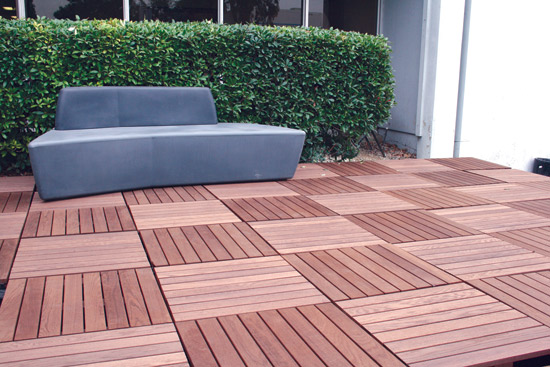
Photo courtesy of Tournesol Siteworks
New thermally modified wood products using domestic lumber can provide UC3B durability (25+ year life), and a Class A flame spread rating. They are splinter, warp, and twist resistant, and will naturally weather to a beautiful, rich patina.
Twenty-five years ago, environmentalists were warning about the destruction of old-growth forests. Primeval forests, composed of hardwoods that are 150 years or older, are prized for their durability, bug resistance, and Class “A” fire rating. As defined by the American Standards of Testing and Materials (ASTM), building materials' fire rating can determine their use in a commercial project. Domestically supplied old-growth lumber, like redwood, has become nearly impossible to find commercially. According to criteria in many green rating systems, the Forest Stewardship Council (FSC) should certify wood selected for use in a project. Founded in 1993, FSC sets standards as to the economic, social, and environmental balance for forests and lumber production.3
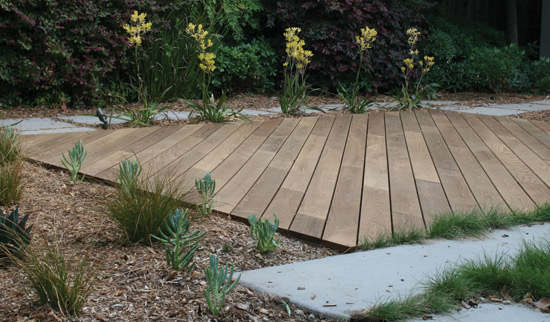
Photo courtesy of Tournesol Siteworks
This wood deck project uses thermally modified wood manufactured from domestic lumber sources.
Commercial owners have come to demand the performance and appearance of South American hardwoods (25+ years unprotected use, high resistance to rot & decay, Class A fire resistance, dimensional stability, and rich dark natural tones) for exterior applications. Architects searching for alternatives for new client demands for sustainable alternatives can now specify thermally modified hardwoods that reduce old-growth logging in the rainforest and still provide the dimensional stability and durability of tropical hardwoods.
Advancements in technology using thermal modification have produced new domestic wood resources as a viable alternative to prevent the continued destruction of fragile ecosystems. Thermal modification is a manufacturing process that originated in Scandinavia, and is used to process tens of millions of board feet annually. Lumber is treated at high temperatures and with steam in special kilns. The process changes the make-up of the wood to create a dark-colored lumber with exceptional rot, pest, and decay resistance. The lumber is 100 percent free of the arsenic, copper, chrome, and other hazardous metals present in pressure-treated wood. In addition to a 25-year plus life span, the wood has a Class A flame spread rating, measured by ASTM E84. The cellular changes that take place in the wood create moisture stability, and prevent warping, twisting, and other wood movement. The wood will naturally weather to a rich patina, similar to the South American hardwoods. No special tools are required to construct decks using this lumber and it can be cut, drilled, and otherwise modified similar to red oak or ash lumber.
In addition to using FSC-certified domestic lumber as a source for thermally modified wood products, architects can also participate in the upcycling of urban forests. The Emerald Ash Borer was discovered in the US in the 1990s, and to date has caused the death of millions of ash trees, many of which were planted as street trees to replace the Elm tree, which had also died decades ago because of an invasive pest. According to the U.S. Forest Service, reclaimed wood from all dead and diseased community trees could equal 3.8 billion board feet or nearly 30% of annual hardwood consumption in the United States. Instead of downcycling this lumber for use as mulch and wood chips, manufacturers are taking advantage of this resource to upcycle or repurpose thermally modified Ash for quality street furniture and wood decking. This reintroduction into the supply chain means not only the reduction of wood harvested in the rainforest, it also reduces the pressure on domestic forests.
Specifying thermally modified upcycled wood from urban forests or wood with FSC certification provides a new means to meet green certifications for renewable resources. Many of these credits focus on the life-cycle analysis of wood used in projects from harvesting through distribution. For example, the United States Green Building Council in version 4 of LEED® is designed to: “encourage the use of products and materials for which life cycle information is available and that have environmentally, economically, and socially preferable life-cycle impacts. To reward project teams for selecting products verified to have been extracted or sourced in a responsible manner.”4 Using FSC-certified wood products contribute to meeting the requirements for MR c7 Certified Wood Credit.
There are also community benefits to upcycling the urban forest. Cities that are losing their tree canopies to disease can take advantage of this lost resource by using the wood for site furnishings, small parks, or as part of community buildings. The recent increase in high-tech solutions for rapidly disappearing resources has benefitted both architects who design new construction as well as those who are involved with the preservation of historic buildings.
Materials and Methods Matter
Using appropriate technology and new materials has created new resources for sustainable designers who are solving environmental challenges. The AIA is beginning a program that will allow architects to track green materials and methods, to help architects choose materials for healthier and more efficient buildings. They encourage architects to carefully choose their materials. They suggest that architects focus on the larger areas of a building that are the big “ticket items” and begin their considerations early in the design process.
The AIA recommends that architects: “Don't compromise on performance. Durability, safety, and energy efficiency are important sustainability characteristics, and the greenest choices help on those fronts as well. Products have to play well with others to create energy-efficient and durable high-performance assemblies. Ideally, these assemblies will also be detailed to allow for easy disassembly when the time comes to replace some of their elements, or even the entire building.”5
For many architects the latest trend in the green movement means the adaptation of smart technology. Increasing energy efficiency, providing digital controls for smaller, plug-in HVAC systems, creating smart spaces with flexible walls, and saving natural resources by upcycling and using new ecological manufacturing processes are just a few of the next wave of new sustainable technology.
ENDNOTES
1. Practicing Architecture: Materials, http://www.aia.org/practicing/materials/index.htm. August 24, 2014.
2. 44 Benefits of Collaborative Learning. http://www.gdrc.org/kmgmt/c-learn/44.html August 25, 2014.
3. FSC. https://us.fsc.org/what-we-do.186.htm August 25, 2014.
4. Building Product Disclosure. http://www.usgbc.org/node/2616388?return=/credits/new-construction/v4/material-%26-resources. August 26, 2014
 |
 |
 |
 |



